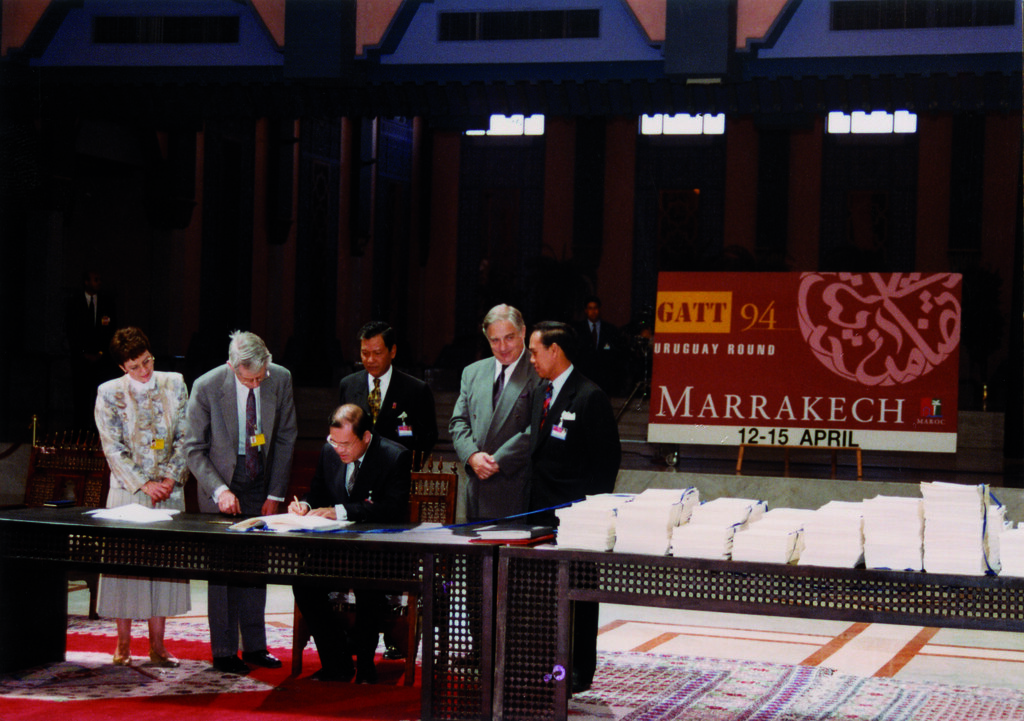Context:
Recently, the 30th anniversary of the Marrakesh Agreement is being celebrated by the World Trade Organization (WTO).
Background of Marrakesh Agreement:
- The Marrakesh Agreement, signed on April 15, 1994, established the World Trade Organization (WTO), which officially commenced operations on January 1, 1995.
- This landmark agreement aimed to enforce binding regulations for global trade, succeeding the General Agreement on Tariffs and Trade (GATT), which had governed international trade since 1948.
- The negotiations leading to the Marrakesh Agreement were part of the Uruguay Round, initiated in 1986 to broaden the scope of GATT and tackle emerging trade challenges. These negotiations concluded in December 1993 in Geneva, paving the way for the historic Marrakesh Agreement.
The World Trade Organization (WTO):
The World Trade Organization (WTO) stands as the sole global international body governing trade regulations among nations. Its objective is to guarantee the smooth, predictable, and unrestricted flow of trade.. Established in 1994 by the Marrakesh Agreement, it plays a critical role in promoting global trade growth and fostering fairer trade practices.
Membership:
- The WTO has 164 members, representing 98% of global trade.
- Currently, 25 countries are in the process of negotiating membership.
Decision-Making:
- Decisions are typically made by the entire membership through consensus.
- All WTO agreements must be ratified by the parliaments of member countries.
Top-Level Bodies:
- The Ministerial Conference, convening every two years, is the highest decision-making body.
- The General Council, comprising ambassadors and delegation heads, meets regularly in Geneva. It also functions as the Trade Policy Review Body and Dispute Settlement Body.
Key Functions of the WTO:
- Setting Trade Rules: The WTO establishes a framework of rules governing trade between member countries. These rules promote:
- Non-discrimination: All WTO members are treated equally (most-favoured-nation treatment), with special considerations given to developing countries.
- Transparency: Members must openly share trade-related policies and regulations.
- Predictability: Rules and procedures aim to provide stability and clarity for international trade.
- Trade monitoring: The WTO’s Trade Policy Review Mechanism aims to enhance transparency, promote a deeper understanding of trade policies among WTO members, and evaluate their impacts.
- Dispute Settlement: Provides a fair resolution platform for trade disputes among members.
- Technical Assistance and Capacity Building: Supports developing nations in trade policy formulation and building institutional capacity.
Benefits of the WTO:
- Promoted Global Trade Growth: The WTO has facilitated significant trade liberalisation, boosting economic growth and job creation worldwide.
- Enhanced Dispute Settlement: The WTO’s dispute settlement system offers a peaceful and predictable way to resolve trade conflicts between member countries.
- Integration of Developing Economies: The WTO provides a framework and resources for developing countries to participate more actively in international trade.
Criticisms of the WTO:
- Focus on Developed Countries: Some argue the system primarily benefits developed nations, overlooking the concerns of developing economies.
- Environmental and Labor Issues: Critics argue the WTO prioritises free trade over environmental protection and labour standards.
- Implementation Challenges: Enforcing trade rules and ensuring compliance across diverse economies can be complex.
Challenges Facing the WTO:
- Despite celebrating the WTO’s 30th anniversary, the rules-based system faces challenges, with enforcement mechanisms like the Appellate Body rendered dysfunctional since December 2019
WTO’s Achievements (Timeline)
| Year | Achievement | Description |
| 1995 | WTO Officially Begins Operations | The World Trade Organization officially commences its work, succeeding the General Agreement on Tariffs and Trade (GATT). |
| 1996 | 1st Ministerial Conference (Singapore) | WTO member countries gather for the first time to discuss trade issues and future goals. |
| 1997 | Information Technology Agreement (ITA) | Tariffs on information technology products are significantly reduced, boosting trade in this sector. |
| 2001 | Doha Development Agenda Launched | A new round of trade negotiations focusing on development issues faced by poorer countries is initiated. |
| 2003 | Least Developed Countries Join WTO (Cambodia & Nepal) | The first least developed countries gain membership in the WTO, promoting their integration into the global trade system. |
| 2005 | Aid for Trade Initiative Launched | A program is established to provide technical assistance and financial support to developing countries to help them benefit more from trade. |
| 2013 | Trade Facilitation Agreement Concluded | An agreement is reached to streamline customs procedures and reduce trade costs for businesses. |
| 2015 | Nairobi Package | A series of agreements are reached, including the abolition of agricultural export subsidies and the expansion of the Information Technology Agreement. |
| 2017 | Amendment to TRIPS Agreement | Changes are made to the agreement on intellectual property rights to ease access to essential medicines for developing countries. |
| 2017 | Trade Facilitation Agreement Enters into Force | The agreement on streamlining customs procedures comes into effect, aiming to simplify trade processes. |
| 2022 | Landmark Fisheries Subsidies Agreement | A significant agreement is reached to regulate and reduce harmful fisheries subsidies that contribute to overfishing. |
| 2024 | 13th Ministerial Conference | WTO member countries meet and reach various decisions on trade-related topics, with a commitment to continue negotiations. |
Conclusion:
Over the past three decades, the WTO has contributed to trade growth, dispute resolution, and the integration of developing economies. However, present challenges emphasise the need for reform and adaptation to address emerging trade complexities and ensure equitable trade practices globally.

